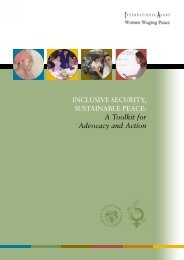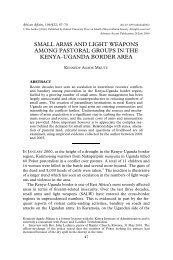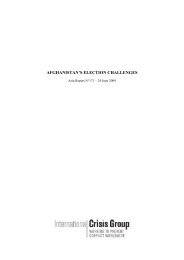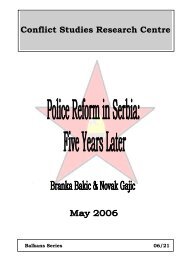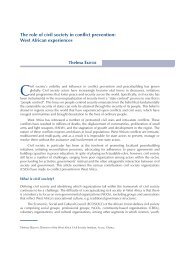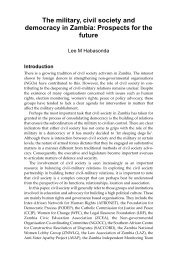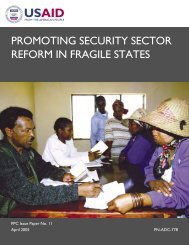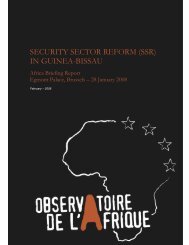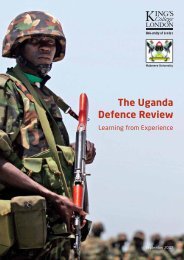The ATT and Military Equipment - Control Arms
The ATT and Military Equipment - Control Arms
The ATT and Military Equipment - Control Arms
You also want an ePaper? Increase the reach of your titles
YUMPU automatically turns print PDFs into web optimized ePapers that Google loves.
eport<br />
<strong>The</strong> <strong>Arms</strong> Trade Treaty<br />
<strong>and</strong> military equipment<br />
<strong>The</strong> case for a comprehensive scope<br />
July 2009
<strong>The</strong> <strong>Arms</strong> Trade Treaty<br />
<strong>and</strong> military equipment<br />
<strong>The</strong> case for a comprehensive scope<br />
SAFERWORLD<br />
JULY 2009
Acknowledgements<br />
This briefing was written by Joseph Farha <strong>and</strong> Roy Isbister of Saferworld.<br />
Saferworld wishes to acknowledge assistance in compiling information for this report<br />
from Daniel Mack of Sou da Paz <strong>and</strong> Zawar Haider Abidi, an export control expert.<br />
Responsibility for the content of this report <strong>and</strong> the views expressed within lies solely<br />
with Saferworld <strong>and</strong> the authors.<br />
COVER PHOTOS<br />
TOP LEFT: Aerial view of a KC-130 aircraft refueling two CH-53 helicopters<br />
PURESTOCK/GETTY IMAGES<br />
TOP RIGHT: Range of Pakistan Ordnance Factory ammunition on display at the International<br />
Defence Exhibition (IDEX) 2007, Abu Dhabi ROBIN BALLANTYNE, OMEGA RESEARCH FOUNDATION<br />
BOTTOM LEFT: <strong>The</strong> Iveco Light Mulirole Vehicle that replaces the VW Iltis jeeps in the<br />
Belgian Army STOCKTREK RF/GETTY IMAGES<br />
BOTTOM RIGHT: Dutch Special Forces protect a cargo ship delivering food aid to Somalia,<br />
June 2008 SVEN TORFINN/PANOS PICTURES<br />
© Saferworld, July 2009. All rights reserved. No part of this publication may be<br />
reproduced, stored in a retrieval system or transmitted in any form or by any means<br />
electronic, mechanical, photocopying, recording or otherwise, without full<br />
attribution. Saferworld welcomes <strong>and</strong> encourages the utilisation <strong>and</strong> dissemination<br />
of the material included in this publication.
1<br />
Introduction<br />
THE POTENTIAL SCOPE of an international <strong>Arms</strong> Trade Treaty (<strong>ATT</strong>) was a<br />
principal subject for discussion during the first meeting of the Open-Ended Working<br />
Group (OEWG1) in March 2009. In particular, discussion centred upon the types of<br />
equipment <strong>and</strong> the types of transactions that an <strong>ATT</strong> should cover. This briefing is<br />
intended as a contribution to the debate on one aspect of the former, i.e. the range of<br />
military equipment to which a Treaty should be applied. It examines the national lists<br />
of military equipment that are currently controlled by a number of national<br />
governments with a view to determining whether there exists a common framework<br />
on which further discussion could be based.<br />
To be fully comprehensive an <strong>ATT</strong> must cover not just weapons platforms <strong>and</strong> systems<br />
but also their ammunition <strong>and</strong> components, arms <strong>and</strong> ammunition production<br />
equipment <strong>and</strong> technologies, internal security equipment, <strong>and</strong> dual-use items intended<br />
for military, security or police use. However, as this paper analyses national military<br />
lists its focus is, by definition, restricted to military equipment <strong>and</strong> technologies.<br />
<strong>The</strong>refore it does not consider questions relating to the control of other equipment<br />
such as dual-use <strong>and</strong> internal security items. <strong>The</strong>re are strong arguments in favour of<br />
an <strong>ATT</strong> encompassing these other types of equipment, however these will not be<br />
explored in detail within this particular publication.<br />
Although this report does not survey all national arms transfer control jurisdictions,<br />
it is clear from the evidence contained herein that the overwhelming majority of arms<br />
transferred internationally – over 98.8 percent (see below) – are from jurisdictions that<br />
cover an extremely broad range of conventional military items, their ammunition<br />
<strong>and</strong> components, to the point where it could be considered that a comprehensive<br />
international st<strong>and</strong>ard is, to all intents <strong>and</strong> purposes, already in place. In addition, as<br />
this paper will demonstrate, there are indications that, as states update their national<br />
transfer control lists it is to this de facto st<strong>and</strong>ard they increasingly turn. This paper<br />
argues that it is both logical <strong>and</strong> efficient to use this approach as the basis for future<br />
discussions <strong>and</strong>/or negotiations concerning the military equipment to be controlled<br />
under an <strong>ATT</strong>.
2<br />
<strong>The</strong> need for a<br />
comprehensive scope<br />
THE CAPABILITY TO EXERT EFFECTIVE CONTROL over the transfer of all military<br />
items from, through or into their national territory is a primary function of all states<br />
<strong>and</strong> an important expression of their sovereignty. This applies to all military<br />
equipment, <strong>and</strong> not just major offensive weapons <strong>and</strong> platforms <strong>and</strong> small arms <strong>and</strong><br />
light weapons (SALW).<br />
At OEWG1 the debate on the possible scope (in terms of types of equipment) of an<br />
<strong>ATT</strong> for the most part centred on whether the seven categories of major conventional<br />
weapons listed under the UN Register of Conventional <strong>Arms</strong> (UNRCA) 1 plus SALW –<br />
often referred to as ‘7+1’ – would be sufficient, or whether coverage should be more<br />
comprehensive. It became clear, however, that for some states the term “more<br />
comprehensive” included only 7+1 plus related ammunition, components <strong>and</strong>/or<br />
production equipment (sometimes referred to as ‘7+1+1+1’). This briefing argues,<br />
however, that such an approach leaves out a wide range of military equipment that is<br />
fundamental to the international trade in conventional arms <strong>and</strong> that is used in the<br />
ongoing prosecution of conflict <strong>and</strong> violations of international human rights law <strong>and</strong><br />
international humanitarian law that are taking place around the world.<br />
<strong>The</strong> problem with 7+1 (+1+1)<br />
While any <strong>ATT</strong> should of course include all equipment covered by the UNRCA <strong>and</strong><br />
should include SALW, it should be remembered that the UNRCA is a transparency<br />
mechanism, not an arms transfer control mechanism, <strong>and</strong> that it is very much a<br />
product of its time <strong>and</strong> strategic context. It was conceived approximately 20 years ago<br />
in response to the end of the Cold War <strong>and</strong> the international arms transfer control<br />
failings that had contributed to the 1991 Gulf War. <strong>The</strong> aim of the UNRCA was to<br />
introduce greater transparency into conventional arms transfers so as to help prevent<br />
destabilising accumulations of armaments; its focus is primarily upon major<br />
conventional weapons systems that could be used to launch large-scale offensive<br />
operations.<br />
Today, the international security context is more varied <strong>and</strong> fragmented <strong>and</strong> the range<br />
of equipment that is used in human rights violations <strong>and</strong> in regions of conflict <strong>and</strong><br />
instability is much greater. An <strong>ATT</strong> premised on controlling 7+1, even if it included<br />
1 <strong>The</strong> seven categories of the UNRCA are battle tanks, armoured combat vehicles, large-calibre artillery systems, combat<br />
aircraft, attack helicopters, some warships (including submarines), <strong>and</strong> missiles <strong>and</strong> missile launchers.
THE CASE FOR A COMPREHENSIVE SCOPE 3<br />
related components, ammunition <strong>and</strong> production equipment, would leave, unregulated,<br />
transfers of an extensive range of conventional weapons, weapons platforms<br />
<strong>and</strong> systems (<strong>and</strong> related components etc) that are widely used in conflict <strong>and</strong> human<br />
rights crisis zones today, including inter alia:<br />
■ military helicopters other than attack helicopters<br />
■ military aircraft that are not combat aircraft<br />
■ most military vessels with a st<strong>and</strong>ard displacement of less than 500 metric tons<br />
■ military vehicles that are not armoured combat vehicles<br />
■ artillery systems with a calibre of less than 75 mm<br />
■ certain unmanned aerial vehicles<br />
■ C4I (Comm<strong>and</strong>, <strong>Control</strong>, Communications, Computers, <strong>and</strong> military Intelligence)<br />
equipment <strong>and</strong> technology. 2<br />
If it is to be effective <strong>and</strong> relevant to the international trade in conventional arms, an<br />
<strong>ATT</strong> should reflect current realities as they exist in the form of national control lists for<br />
strategic goods. An <strong>ATT</strong> based on 7+1 (or even 7+1+1+1) would leave large loopholes<br />
<strong>and</strong> would ultimately be inadequate in terms of introducing responsibility <strong>and</strong><br />
restraint into the international trade in conventional arms. Moreover, a scope that is<br />
significantly narrower than that generally applied at the national level (see below)<br />
could serve to weaken individual states’ existing control systems by encouraging states<br />
to stop regulating transfers of important military equipment.<br />
Existing national <strong>and</strong> multilateral control lists<br />
Rather than drawing on an ill-suited arms transfer transparency mechanism as the<br />
basis for establishing the range of items to which an arms transfer control instrument<br />
should apply, this paper explores the applicability of using existing practice at national<br />
<strong>and</strong> regional/multilateral level in determining the scope for an <strong>ATT</strong>. Many states have<br />
already established comprehensive national lists of military equipment subject to<br />
licensing controls, <strong>and</strong> many of these are consistent with the control lists that have been<br />
elaborated by existing regional <strong>and</strong> multilateral agreements such as the Wassenaar<br />
Arrangement Munitions List <strong>and</strong> the EU Consolidated <strong>Military</strong> List. 3 <strong>The</strong>se lists are<br />
the product of a great deal of time <strong>and</strong> effort by officials with significant expertise in<br />
this issue area, <strong>and</strong> thus would seem particularly relevant to any discussions on <strong>ATT</strong><br />
scope.<br />
Methodology<br />
For this paper Saferworld sought information on 53 national regimes, focusing on the<br />
world’s main exporting states of conventional military equipment for the period<br />
2003–07, as identified by the Stockholm International Peace Research Institute<br />
(SIPRI). 4 In addition we selected a small group of other states from regions that would<br />
otherwise be under-represented. By examining national legislation/regulations, by<br />
contacting relevant officials <strong>and</strong> on the basis of membership of existing multilateral<br />
regimes, we have sought to undertake an analysis of these 53 countries’ national<br />
control lists against 21 broadly defined categories of military equipment. <strong>The</strong>se include<br />
inter alia:<br />
2 <strong>The</strong> US Pentagon refers to C4ISR (Comm<strong>and</strong>, <strong>Control</strong>, Communications, Computers, Intelligence, Surveillance, <strong>and</strong><br />
Reconnaissance); the UK to C4ISTAR (Comm<strong>and</strong>, <strong>Control</strong>, Communications, Computers, military Intelligence, Surveillance,<br />
Target Acquisition <strong>and</strong> Reconnaissance). In general this type of terminology describes equipment that enables the direction<br />
of military force.<br />
3 <strong>The</strong> Wassenaar Arrangement Munitions List <strong>and</strong> the EU <strong>Military</strong> List are almost identical; differences relate solely to<br />
addressing the implications of the different memberships. <strong>The</strong> EU <strong>Military</strong> List is updated as soon as possible after the<br />
Wassenaar Arrangement Munitions List is revised each December.<br />
4 ‘Table 7A.4. <strong>The</strong> suppliers of major conventional weapons, 2003–07’, SIPRI Yearbook 2008, Oxford University Press,<br />
pp. 325–6.
4 THE ARMS TRADE TREATY AND MILITARY EQUIPMENT<br />
■ SALW<br />
■ artillery of all calibres<br />
■ explosive devices <strong>and</strong> charges<br />
■ all types of military vehicles<br />
■ all types of naval vessels<br />
■ armoured or protective equipment<br />
■ military training equipment<br />
■ all types of military aircraft<br />
■ imaging or countermeasures equipment<br />
■ production equipment<br />
■ directed energy weapons<br />
■ military software<br />
■ components <strong>and</strong> ammunition for the above.<br />
By undertaking this analysis we hope to show the level of commonality that exists<br />
among states’ national military lists.<br />
Comprehensive, <strong>and</strong> similar, national control lists<br />
As is shown below, there is considerable similarity across the control lists operated by<br />
a large number of states. <strong>The</strong> vast majority include the UNRCA’s seven categories of<br />
major conventional weapons plus SALW (i.e. 7+1) while going far beyond this<br />
typology. <strong>The</strong> level of similarity among national control lists is to be expected, however.<br />
Given the challenges involved in independently developing <strong>and</strong> updating lists of<br />
strategic goods it would seem likely that governments will have drawn upon work<br />
already undertaken by others whether at national or regional/multilateral level. This<br />
paper argues that a similar pragmatic approach (i.e. drawing upon widely-shared<br />
existing practice) is appropriate to defining <strong>and</strong> elaborating the scope of an <strong>ATT</strong>.<br />
Table 1 (below) sets out the results of our research for all the states surveyed, including<br />
those where no information was forthcoming. At least 38 of the 53 states surveyed<br />
control all 21 of the broad categories we have identified. Together these 38 states<br />
account for more than 98.8 percent of all military equipment exported during the<br />
period 2003–07. 5 <strong>The</strong> actual figures may be higher, as for five of the 53 states we were<br />
unable to gather any data, <strong>and</strong> for eight other states the data available was incomplete<br />
<strong>and</strong>/or ambiguous. In all such cases we have taken a conservative approach; equipment<br />
has not been categorised as controlled where doubt exists. However for only two of the<br />
countries surveyed have we explicitly concluded that specific categories of military<br />
equipment are not controlled.<br />
Discounting those states for which we have no data, controls were most complete with<br />
regard to weapons that fired projectiles (i.e. SALW <strong>and</strong> “heavy weapons”) <strong>and</strong> their<br />
ammunition. For these categories data was incomplete or ambiguous in only three<br />
instances <strong>and</strong> the equipment controlled in all others. <strong>The</strong> situation was slightly more<br />
mixed for other types of equipment; most problematic would appear to be items<br />
such as kinetic energy weapons, forgings <strong>and</strong> castings, directed energy weapons, <strong>and</strong><br />
cryogenic <strong>and</strong> superconductive material (unclear for seven states; apparently uncontrolled<br />
in two).<br />
Availability of information<br />
Some states proved either reluctant or slow to share information about the range of<br />
military equipment they control. This is problematic in that, if potential exporting<br />
companies within those states also struggle to access this information, there is a risk<br />
that those companies could transfer strategic equipment against the wishes of their<br />
governments <strong>and</strong>, inadvertently, in breach of national law. We therefore urge all states<br />
5 Ibid.
THE CASE FOR A COMPREHENSIVE SCOPE 5<br />
to make this information publicly available, not only upon request but also through<br />
publication.<br />
But even where information is publicly available, without a detailed control list there<br />
is a real risk of ambiguity regarding the equipment actually covered. In several cases<br />
we came across examples where it was not clear whether certain equipment was<br />
subject to control. This, too, has implications for exporters who may find themselves<br />
unintentionally in breach of national transfer control regulations while potentially<br />
contributing to the uncontrolled spread of military equipment.<br />
Alternatives to control lists <strong>and</strong> the problems with such approaches<br />
It seems some states do not control the transfer of equipment under all 21 categories<br />
in the table below through the use of a national control list. Included among the<br />
justifications given by states for this was that, in some cases, the government wields<br />
effective control over arms transfers by other means. This could mean, for example,<br />
that only the national armed forces are permitted to be involved in the use <strong>and</strong><br />
movement of military items, or that the state owns or has complete control over the<br />
national defence industry (as is the case in, for example, Brazil <strong>and</strong> Pakistan). Another<br />
argument used to justify the limited scope of national transfer controls is that a lack of<br />
an indigenous defence-manufacturing base obviates the need for a comprehensive<br />
control list (an approach espoused by Kenya).<br />
<strong>The</strong>se types of approach to the control of transfers of strategic goods do not take<br />
account of global developments in arms production <strong>and</strong> trade <strong>and</strong> are of concern for<br />
a variety of reasons. More <strong>and</strong> more states are developing a national defence<br />
manufacturing capacity <strong>and</strong> buyers of military equipment now frequently attempt<br />
to leverage local involvement in manufacture as a condition of purchase. Typically,<br />
this new production will comprise smaller <strong>and</strong> lower-tech items, or components <strong>and</strong><br />
sub-assemblies. It may also involve a shift from exclusively state-run or -controlled<br />
production to greater involvement of commercial actors. <strong>The</strong>se developments<br />
together undermine the idea that military equipment transfers can be effectively<br />
managed without recourse to a comprehensive, explicit control list.<br />
In addition, all states have a responsibility to control the transit/transhipment <strong>and</strong><br />
brokering of strategic goods when it falls within their jurisdiction. <strong>Control</strong>ling arms<br />
transfers without the use of comprehensive national control lists fails to take account<br />
of these responsibilities. This is the case irrespective of whether a government has<br />
direct control of production <strong>and</strong> ownership of military equipment within their<br />
national territory. <strong>The</strong> reality is that arms can transit or be transhipped through any<br />
state, <strong>and</strong> that arms brokers can base their operations anywhere they can access<br />
modern communications. All states must therefore consider these issues when<br />
constructing their arms transfer control systems.<br />
National trend to improved control lists<br />
Recent statements in international fora 6 <strong>and</strong> developments at the national level in<br />
improving arms transfer control systems suggest that more states are becoming aware<br />
of these issues. States that have recently updated their transfer control legislation have<br />
tended to develop more detailed <strong>and</strong> comprehensive control lists <strong>and</strong> to grant easier<br />
public access to them. 7 This suggests that over time more states will apply controls to a<br />
range of equipment more in keeping with that set out in Table 1 below. It would be an<br />
unfortunate outcome of an <strong>ATT</strong> if its provisions on scope actually reversed recent<br />
progress being made nationally, regionally <strong>and</strong> multilaterally.<br />
6 See, for example, the Report of the Third Biennial Meeting of States to Consider the Implementation of the Programme of<br />
Action to Prevent, Combat <strong>and</strong> Eradicate the Illicit Trade in Small <strong>Arms</strong> <strong>and</strong> Light Weapons in All Its Aspects, July 2008,<br />
section IV.II, para. 16, http://daccessdds.un.org/doc/UNDOC/GEN/N08/467/96/PDF/N0846796.pdf?OpenElement.<br />
7 Examples among the 53 states surveyed for this report where the national control lists have recently been updated to follow<br />
this more comprehensive model include India, Israel, Jordan <strong>and</strong> Montenegro.
6<br />
SALW/components<br />
Heavy weapons/components<br />
Ammunition <strong>and</strong><br />
fuses/components<br />
Explosive devices <strong>and</strong><br />
charges/components<br />
Fire-control <strong>and</strong> related<br />
equipment<br />
Armoured<br />
vehicles/components<br />
Chemical <strong>and</strong> biological<br />
agents/components<br />
Explosives <strong>and</strong><br />
propellants/components<br />
<strong>Military</strong> vessels (surface or<br />
underwater)/components<br />
Table 1:<br />
Types of military<br />
equipment controlled<br />
by selected states<br />
Key<br />
X <strong>Equipment</strong> is controlled<br />
NI No information provided<br />
A Information available is<br />
ambiguous<br />
NC <strong>Equipment</strong> is not<br />
controlled<br />
See Annex 1 for background<br />
information on the basis <strong>and</strong>/or<br />
source of information on the<br />
items subject to control in<br />
surveyed States<br />
See Annex 2 for an elaboration<br />
of the 21 categories of military<br />
equipment<br />
Saferworld will be updating <strong>and</strong><br />
exp<strong>and</strong>ing this table over time.<br />
For the latest version of this table<br />
see: www.saferworld.org.uk/<br />
publications.php?id=399<br />
Algeria A A A A NI NI NI NI NI<br />
Argentina X X X X X X X X X<br />
Australia X X X X X X X X X<br />
Austria X X X X X X X X X<br />
Belarus X X X X X X X X X<br />
Belgium X X X X X X X X X<br />
Brazil X X X X X X X X NC<br />
Bulgaria X X X X X X X X X<br />
Canada X X X X X X X X X<br />
China X X X X X X X X X<br />
Colombia X X X X A A A A A<br />
Czech Republic X X X X X X X X X<br />
Denmark X X X X X X X X X<br />
Egypt NI NI NI NI NI NI NI NI NI<br />
Finl<strong>and</strong> X X X X X X X X X<br />
France X X X X X X X X X<br />
Germany X X X X X X X X X<br />
Greece X X X X X X X X X<br />
Hungary X X X X X X X X X<br />
India X X X X X X X X X<br />
Indonesia X X X X X A A X X<br />
Israel X X X X X X X X X<br />
Italy X X X X X X X X X<br />
Japan X X X X X X X X X<br />
Jordan X X X X X X X X X<br />
Kazakhstan X X X X X X X X X<br />
Kenya NI NI NI NI NI NI NI NI NI<br />
Kyrgyzstan A A A A A A A A A<br />
Libya NI NI NI NI NI NI NI NI NI<br />
Mexico X X X X A A A A A<br />
Montenegro X X X X X X X X X<br />
Morocco X X X X A X A A A<br />
Netherl<strong>and</strong>s X X X X X X X X X<br />
Nigeria NI NI NI NI NI NI NI NI NI<br />
Norway X X X X X X X X X<br />
Pakistan X X X X A A X X A<br />
Pol<strong>and</strong> X X X X X X X X X<br />
Romania X X X X X X X X X<br />
Russia X X X X X X X X X<br />
Singapore X X X X X X X X X<br />
Slovakia X X X X X X X X X<br />
South Africa X X X X X X X X X<br />
South Korea X X X X X X X X X<br />
Spain X X X X X X X X X<br />
Sri Lanka NI NI NI NI NI NI NI NI NI<br />
Sweden X X X X X X X X X<br />
Switzerl<strong>and</strong> X X X X X X X X X<br />
Turkey X X X X X X X X X<br />
Ug<strong>and</strong>a X X X NC NC NC NC NC NC<br />
Ukraine X X X X X X X X X<br />
United Arab Emirates A A A A A A A A A<br />
United Kingdom X X X X X X X X X<br />
United States of America X X X X X X X X X
Aircraft (Iincluding unmanned<br />
aerial vehicles/components<br />
Kinetic energy<br />
weapons/components<br />
Amoured or protective<br />
equipment/components<br />
<strong>Military</strong> training<br />
equipment/components<br />
Imaging or countermeasures<br />
equipment/components<br />
Forgings/castings/unfinished<br />
products/components<br />
Misc. equipment/libraries<br />
Production<br />
equipment/components<br />
Directed energy<br />
weapons/components<br />
Cryogenic/superconductive<br />
material/components<br />
Software/components<br />
<strong>Military</strong> technology<br />
7<br />
Algeria NI NI NI NI NI NI NI NI NI NI NI NI<br />
Argentina X X X X X X X X X X X X<br />
Australia X X X X X X X X X X X X<br />
Austria X X X X X X X X X X X X<br />
Belarus X X X X X X X X X X X X<br />
Belgium X X X X X X X X X X X X<br />
Brazil NC NC X NC X NC NC X NC NC NC X<br />
Bulgaria X X X X X X X X X X X X<br />
Canada X X X X X X X X X X X X<br />
China X X X X X X X X X X X X<br />
Colombia A A A A A A A A A A A A<br />
Czech Republic X X X X X X X X X X X X<br />
Denmark X X X X X X X X X X X X<br />
Egypt NI NI NI NI NI NI NI NI NI NI NI NI<br />
Finl<strong>and</strong> X X X X X X X X X X X X<br />
France X X X X X X X X X X X X<br />
Germany X X X X X X X X X X X X<br />
Greece X X X X X X X X X X X X<br />
Hungary X X X X X X X X X X X X<br />
India X X X X X X X X X X X X<br />
Indonesia X A A X A A A X A A A A<br />
Israel X X X X X X X X X X X X<br />
Italy X X X X X X X X X X X X<br />
Japan X X X X X X X X X X X X<br />
Jordan X X X X X X X X X X X X<br />
Kazakhstan X X X X X X X X X X X X<br />
Kenya NI NI NI NI NI NI NI NI NI NI NI NI<br />
Kyrgyzstan A A A A A A A A A A A A<br />
Libya NI NI NI NI NI NI NI NI NI NI NI NI<br />
Mexico A A A A A A A A A A A A<br />
Montenegro X X X X X X X X X X X X<br />
Morocco A A A A A A A A A A A A<br />
Netherl<strong>and</strong>s X X X X X X X X X X X X<br />
Nigeria NI NI NI NI NI NI NI NI NI NI NI NI<br />
Norway X X X X X X X X X X X X<br />
Pakistan X A A A A A A A A A A A<br />
Pol<strong>and</strong> X X X X X X X X X X X X<br />
Romania X X X X X X X X X X X X<br />
Russia X X X X X X X X X X X X<br />
Singapore X X X X X X X X X X X X<br />
Slovakia X X X X X X X X X X X X<br />
South Africa X X X X X X X X X X X X<br />
South Korea X X X X X X X X X X X X<br />
Spain X X X X X X X X X X X X<br />
Sri Lanka NI NI NI NI NI NI NI NI NI NI NI NI<br />
Sweden X X X X X X X X X X X X<br />
Switzerl<strong>and</strong> X X X X X X X X X X X X<br />
Turkey X X X X X X X X X X X X<br />
Ug<strong>and</strong>a NC NC NC NC NC NC NC NC NC NC NC NC<br />
Ukraine X X X X X X X X X X X X<br />
United Arab Emirates A A A A A A A A A A A A<br />
United Kingdom X X X X X X X X X X X X<br />
United States of America X X X X X X X X X X X X
8 THE ARMS TRADE TREATY AND MILITARY EQUIPMENT<br />
It is an open question as to how an <strong>ATT</strong> could best manage the process of establishing<br />
exactly what military equipment should be controlled, <strong>and</strong> how this would be updated<br />
over time. One approach would be for states to agree a detailed list, which would then<br />
need to be periodically updated to allow for changes in technology <strong>and</strong> weapons<br />
development through a mechanism established by the Treaty. Alternatively, an <strong>ATT</strong><br />
could set out a list of broad categories of equipment to be subject to control (for<br />
example as has been done in the table above). National authorities would then be<br />
responsible for ensuring that their national lists were consistent with these obligations,<br />
while in addition the Treaty would need to establish an international mechanism to<br />
monitor <strong>and</strong> assist compliance. Whichever approach is followed, the primary concern<br />
should be to establish an <strong>ATT</strong> that is truly comprehensive in scope.
3<br />
Conclusions<br />
THIS PAPER CLEARLY DEMONSTRATES that states already appreciate the need to<br />
control all types of military equipment; more than 98.8 percent of military equipment<br />
subject to international transfer is currently sourced from jurisdictions that use<br />
comprehensive national lists.<br />
Our research reveals that there is a remarkable amount of similarity among the<br />
national control lists in use. For members of the EU or the Wassenaar Arrangement<br />
this is to be expected, however this similarity extends to other states as well. Indeed the<br />
extent of commonality across so many states, from all regions, confirms the hypothesis<br />
that there is already in place a de facto international st<strong>and</strong>ard for this aspect of arms<br />
transfer control scope. This paper argues that the scope of an <strong>ATT</strong> should build upon<br />
this existing transfer control st<strong>and</strong>ard, rather than premising scope discussions on<br />
variations of the theme of 7+1 (SALW plus the categories of the UNRCA – a<br />
transparency mechanism that was created in a different era for an entirely different<br />
purpose).<br />
Moreover, if <strong>ATT</strong> scope were to be based on a variation of the 7+1 formulation, there<br />
are many states that would continue to use their current, much broader list of military<br />
equipment at the national level. Rather than establishing agreed global st<strong>and</strong>ards for<br />
arms transfer controls – one rationale behind the calls for an <strong>ATT</strong> – this would in effect<br />
promote the establishment of two different levels of regulation.<br />
Crucially, although many states may continue with their existing national lists, an<br />
<strong>ATT</strong> based on 7+1 could encourage some states to reduce the range of equipment they<br />
already control. Such a development would clearly be an extremely retrograde step,<br />
all the more so because it runs counter to the current trend among individual states to<br />
adopt more comprehensive control lists. It would also complicate capacity-building<br />
programmes. States are likely to be disinclined to build capacity to a lower st<strong>and</strong>ard<br />
than their own, yet setting scope based on the 7+1 approach would tend to<br />
delegitimise (<strong>and</strong> disincentivise) capacity-building that goes further.<br />
All these factors raise significant doubts about the utility of 7+1 as a start point for<br />
discussions on <strong>ATT</strong> scope. Almost all items categorised as military are already subject<br />
to transfer controls by a significant number of states. To introduce a new global<br />
agreement that ignores this reality <strong>and</strong> in fact sets a much lower st<strong>and</strong>ard would be<br />
counter-productive <strong>and</strong> could serve to undermine the very idea of an <strong>ATT</strong>. Instead,<br />
states should endorse the compelling case for basing the scope of military equipment<br />
to be controlled under an <strong>ATT</strong> on the existing comprehensive st<strong>and</strong>ard already in use<br />
by the states that are responsible for 98.8 percent of the global arms trade.
Annex 1:<br />
Basis <strong>and</strong>/or source of information on the items<br />
subject to control in surveyed states<br />
Algeria Our unconfirmed underst<strong>and</strong>ing is that responsibility for licensing the export of<br />
strategic goods falls to the Ministry of Defence <strong>and</strong>/or the Ministry of the Interior, <strong>and</strong> that the<br />
relevant legislation covering the export of military equipment is Ordonnance No 97-06<br />
(21 January 1997) <strong>and</strong> Décret executive No 98-97 (18 March 1998). <strong>The</strong> first of these makes<br />
reference to types of equipment falling within the first four of our categories, however it is not<br />
clear precisely what equipment is controlled.<br />
Argentina Member of Wassenaar Arrangement; uses Wassenaar Munitions List.<br />
Austria Member of Wassenaar Arrangement <strong>and</strong> EU; uses EU <strong>Military</strong> List.<br />
Belarus Ministry of Foreign Affairs of Belarus website,<br />
http://www.mfa.gov.by/ru/foreign-policy/multilateral/mb/e5f4a881483b3086.html.<br />
Belgium Member of Wassenaar Arrangement <strong>and</strong> EU; uses EU <strong>Military</strong> List.<br />
Brazil <strong>The</strong> authority vested with arms export controls is the Divisaõ Fiscalizaçaõ de Produtos<br />
<strong>Control</strong>ados (DFPC) of the Brazilian Army. <strong>The</strong> relevant legislation that covers arms exports<br />
from Brazil is Decree 3665 (2000) [R-105]<br />
(http://www.dfpc.eb.br/index.php?option+com_content&task=view&id=31).<br />
Brazil apparently controls “heavy armaments”, however the precise meaning of this term is<br />
unclear. <strong>The</strong>re is no explicit reference in the legislation to naval vessels, aircraft, kinetic weapons,<br />
cryogenic equipment, forgings <strong>and</strong> castings, specialised training equipment, direct energy<br />
weapons, libraries or software, or to components for any of the above.<br />
Bulgaria Member of Wassenaar Arrangement <strong>and</strong> EU; uses EU <strong>Military</strong> List.<br />
Canada Member of Wassenaar Arrangement; uses Wassenaar Munitions List.<br />
China <strong>The</strong> relevant legislation containing the control is the 2004 Regulations of the Peoples<br />
Republic on the Administration of <strong>Arms</strong> Exports, which contain the <strong>Military</strong> Products Export<br />
<strong>Control</strong> List (http://www.fmprc.gov.cn/eng/backup/jksbf/cjjk/2622/t70218.htm).<br />
Colombia <strong>The</strong> relevant legislation governing the export, import <strong>and</strong> manufacture of military<br />
equipment from, to or in Colombia is Decreto 2535 (1993). Article 2 states that only the<br />
government can export, import or manufacture arms, ammunition, explosives, raw materials,<br />
<strong>and</strong> machinery <strong>and</strong> devices for their manufacture. Article 8 identifies the equipment subject to<br />
control, however this may leave out many types of military equipment, for example most major<br />
conventional weapons systems <strong>and</strong> platforms.<br />
Czech Republic Member of Wassenaar Arrangement <strong>and</strong> EU; uses EU <strong>Military</strong> List.<br />
Denmark Member of Wassenaar Arrangement <strong>and</strong> EU; uses EU <strong>Military</strong> List.<br />
Egypt No information available.<br />
Finl<strong>and</strong> Member of Wassenaar Arrangement <strong>and</strong> EU; uses EU <strong>Military</strong> List.<br />
France Member of Wassenaar Arrangement <strong>and</strong> EU; uses EU <strong>Military</strong> List.<br />
Germany Member of Wassenaar Arrangement <strong>and</strong> EU; uses EU <strong>Military</strong> List.<br />
Greece Member of Wassenaar Arrangement <strong>and</strong> EU; uses EU <strong>Military</strong> List.<br />
Hungary Member of Wassenaar Arrangement <strong>and</strong> EU; uses EU <strong>Military</strong> List.<br />
India Annexure VI to Appendix D of the Defence Procurement Policy (DPP) 2008, Special<br />
Chemicals, Organisms, Materials, <strong>Equipment</strong> <strong>and</strong> Technologies List (SCOMET). Notification<br />
No. 15 (RE-05/2004–2009) sets out all the conventional arms subject to Indian arms export<br />
controls.<br />
Indonesia Information obtained from the Ministry of Foreign Affairs was incomplete at time<br />
of writing.
THE CASE FOR A COMPREHENSIVE SCOPE 11<br />
Israel Defense Export <strong>Control</strong> Law, 5766-2007, regulates control over the Wassenaar<br />
Arrangement Munitions List. See, for example, statement by Ambassador Miriam Ziv, Deputy-<br />
Director General for Strategic Affairs, Ministry of Foreign Affairs, Jerusalem. General Debate of<br />
the UN First Committee, 15 October 2007 (http://israel-un.mfa.gov.il/mfm/Data/123875.doc).<br />
Italy Member of Wassenaar Arrangement <strong>and</strong> EU; uses EU <strong>Military</strong> List.<br />
Japan Member of Wassenaar Arrangement; uses Wassenaar Munitions List.<br />
Jordan According to the Jordan Customs Service, Jordan has incorporated the EU <strong>Military</strong> List<br />
into its export control system.<br />
Kazakhstan 2007 Export <strong>Control</strong> Law of the Republic of Kazakhstan, N300-3<br />
(http://www.cis.minsk.by/main.aspx?uid=8682;<br />
http://www.knb.kz/admin/upload/files/Postan_prav_ot%2018_08_2000.html).<br />
Kenya While we have been informed that Kenya does operate a control list, we received no<br />
information about the range of equipment covered by such a list.<br />
Kyrgyzstan According to the Resolution No. 709 of the Government of the Kyrgyz Republic,<br />
29 October 1998 (http://www.minfin.kg/modules/smartsection/item.php?itemid=328),<br />
Kyrgyzstan currently controls 18 categories of equipment for export <strong>and</strong> 13 for import.<br />
However this Resolution mentions only the number of items, not the exact type of equipment<br />
covered. <strong>The</strong>re is currently a draft export control list awaiting adoption (see<br />
http://www.cecorg.com/en/content/0000000016/), though the main focus of this control list<br />
appears to be nuclear, chemical, biological <strong>and</strong> dual-use equipment <strong>and</strong> components. <strong>The</strong>re is<br />
very little reference to conventional military equipment, though there may be reference in this<br />
draft list to some naval equipment. It is not clear whether the new list will replace or run<br />
alongside Resolution 709.<br />
Libya No information available.<br />
Mexico Article 41 (drawing from articles 9 <strong>and</strong> 10) of Ley Federal De Armas De Fuego Y<br />
Explosivos, last amended in 2004, contains the national control list, which covers SALW,<br />
explosives <strong>and</strong> a wide range of chemicals. It does not include naval vessels, artillery, armoured<br />
vehicles, specific small arms, fuses, explosive device such as mines, rockets, torpedoes <strong>and</strong><br />
bombs <strong>and</strong> certain chemical munitions, all of which are listed as being for the exclusive use of<br />
the Mexican military (Article 11). It was not clear if this equipment is subject to arms transfer<br />
controls by other means.<br />
Montenegro According to the Annual Report on Foreign Trade in <strong>Control</strong>led Goods 2007,<br />
published by its Ministry of Economic Development, Montenegro has harmonised its export<br />
control lists with the EU <strong>Military</strong> <strong>and</strong> Dual-Use Lists.<br />
Morocco According to the Kingdom of Morocco Customs Service, Moroccan export controls<br />
are governed by Prohibitions Spécifiques d’Importation et d’Exportation<br />
(http://www.douane.gov.ma/rdii/PDF/t12ch20s01.pdf). <strong>The</strong> control list is potentially very<br />
broad, however the terminology is frequently unclear. It makes reference to weapons of war <strong>and</strong><br />
weapons held by foreign armies, to all explosive devices <strong>and</strong> all non-portable weapons. While we<br />
were able to identify some specific equipment that is controlled (e.g. small arms <strong>and</strong> light<br />
weapons, explosives <strong>and</strong> detonators), in many cases the specifics were unclear.<br />
Netherl<strong>and</strong>s Member of Wassenaar Arrangement <strong>and</strong> EU; uses EU <strong>Military</strong> List.<br />
Nigeria No Information available.<br />
Norway Member of Wassenaar Arrangement; uses Wassenaar Munitions List.<br />
Pakistan <strong>The</strong> framework that Pakistan uses to control the export of strategic goods is laid out<br />
in the Pakistan Import <strong>and</strong> Export (<strong>Control</strong>) Act 1950. A number of other laws are also relevant,<br />
such as the Pakistan <strong>Arms</strong> Ordinance 1965, the Explosives Act 1884 <strong>and</strong> the Export <strong>Control</strong> on<br />
Goods, Technologies, Material <strong>and</strong> <strong>Equipment</strong> related to Nuclear <strong>and</strong> Biological Weapons <strong>and</strong><br />
their Delivery Systems Act 2004. <strong>The</strong> National Export Policy Procedure Order (EPO), which is<br />
revised annually, establishes that the transfer of arms, ammunition, explosives <strong>and</strong> ingredients<br />
thereof are subject to control. <strong>The</strong>se terms are elaborated in the Pakistan <strong>Arms</strong> Ordinance 1965.<br />
Under the EPO, complete rockets <strong>and</strong> UAV systems <strong>and</strong> their parts <strong>and</strong> anti personnel<br />
l<strong>and</strong>mines are also controlled. However, the elaboration in the Pakistan <strong>Arms</strong> Ordinance 1965<br />
would suggest that a significant range of military equipment may not be expressly controlled –<br />
e.g. naval vessels, military aircraft, <strong>and</strong> armoured vehicles – however the terminology used is<br />
ambiguous. Pakistan uses more comprehensive lists to control the import of equipment into
12 THE ARMS TRADE TREATY AND MILITARY EQUIPMENT<br />
Pakistan (there are controls, for example, on the import of tanks <strong>and</strong> other armoured fighting<br />
vehicles, all aircraft, <strong>and</strong> machinery for the manufacture of arms <strong>and</strong> of radioactive material),<br />
while all domestic military equipment production is tightly controlled by the state.<br />
Pol<strong>and</strong> Member of Wassenaar Arrangement <strong>and</strong> EU; uses EU <strong>Military</strong> List.<br />
Romania Member of Wassenaar Arrangement <strong>and</strong> EU; uses EU <strong>Military</strong> List.<br />
Russia Member of Wassenaar Arrangement; uses Wassenaar Munitions List.<br />
Singapore <strong>The</strong> relevant legislation is the Strategic Goods (<strong>Control</strong>) Order 2009<br />
(http://www.customs.gov.sg/stgc/leftNav/ove/Legislation.htm).<br />
Slovakia Member of Wassenaar Arrangement <strong>and</strong> EU; uses EU <strong>Military</strong> List.<br />
South Africa Member of Wassenaar Arrangement; uses Wassenaar Munitions List.<br />
South Korea Member of Wassenaar Arrangement; uses Wassenaar Munitions List.<br />
Spain Member of Wassenaar Arrangement <strong>and</strong> EU; uses EU <strong>Military</strong> List.<br />
Sri Lanka No information available.<br />
Sweden Member of Wassenaar Arrangement <strong>and</strong> EU; uses EU <strong>Military</strong> List.<br />
Switzerl<strong>and</strong> Member of Wassenaar Arrangement; uses Wassenaar Munitions List.<br />
Turkey Member of Wassenaar Arrangement; uses Wassenaar Munitions List.<br />
Ug<strong>and</strong>a Small arms, ammunition, artillery, flame-throwers, bombs <strong>and</strong> grenades <strong>and</strong><br />
‘apparatus for the discharge of explosive <strong>and</strong> gas diffusing projectiles’ are controlled under the<br />
Firearms Act 1970. We underst<strong>and</strong> Ug<strong>and</strong>a has more up-to-date relevant legislation, but as at<br />
time of writing no additional information was available.<br />
Ukraine Member of Wassenaar Arrangement; uses Wassenaar Munitions List.<br />
United Arab Emirates <strong>The</strong> relevant law regarding the export of strategic goods from the UAE<br />
is Federal Law 13, 2007. At time of writing, we were unable to obtain a copy of this law.<br />
United Kingdom Member of Wassenaar Arrangement <strong>and</strong> EU; uses EU <strong>Military</strong> List.<br />
United States of America Member of Wassenaar Arrangement; uses Wassenaar Munitions List.
Annex 2:<br />
Elaboration of categories of military equipment<br />
from Table 1<br />
<strong>The</strong> 21 categories of equipment in Table 1 are based broadly on the Wassenaar Arrangement<br />
Munitions List. <strong>The</strong>se categories cover the following:<br />
Small arms <strong>and</strong> light weapons (SALW) <strong>and</strong> components All SALW <strong>and</strong> their components,<br />
<strong>and</strong> associated equipment such as silencers.<br />
Heavy weapons <strong>and</strong> components Larger-calibre items <strong>and</strong> their components, such as guns,<br />
howitzers, mortars, projectile launchers, anti-tank weapons, smoothbore weapons <strong>and</strong> military<br />
flamethrowers, military smoke <strong>and</strong> pyrotechnic generators <strong>and</strong> projectors <strong>and</strong> signature<br />
reduction devices.<br />
Ammunition/fuses <strong>and</strong> components Encompasses the entire range of ammunition calibres,<br />
as well fuses <strong>and</strong> constituent components.<br />
Explosive devices/charges <strong>and</strong> components Includes bombs, torpedoes, rockets, missiles,<br />
grenades, smoke canisters, mines, depth charges, demolition-charges, demolition-devices,<br />
demolition-kits, pyrotechnic devices, cartridges <strong>and</strong> simulators (i.e., equipment simulating the<br />
characteristics of any of these items). This category also includes smoke grenades, fire <strong>and</strong><br />
incendiary bombs <strong>and</strong> explosive devices, missile rocket nozzles <strong>and</strong> re-entry vehicle nose-tips,<br />
as well as equipment designed for the h<strong>and</strong>ling, controlling, activating, powering, launching,<br />
laying, sweeping, discharging, decoying, jamming, detonating, disrupting, disposing or<br />
detecting of any of the above or improvised explosive devices.<br />
Fire-control <strong>and</strong> related equipment Includes fire-control <strong>and</strong> related alert <strong>and</strong> warning<br />
equipment, test <strong>and</strong> alignment <strong>and</strong> countermeasures equipment, weapon sights, bombing<br />
computers, gun-laying equipment <strong>and</strong> weapon control systems, target acquisition, designation,<br />
range-finding, surveillance or tracking systems; detection, data fusion, recognition or<br />
identification equipment; <strong>and</strong> sensor integration equipment.<br />
Ground vehicles <strong>and</strong> components All armoured vehicles including tanks, armoured personnel<br />
carriers, vehicles upgraded with armour plate <strong>and</strong> constituent components, vehicles with a<br />
cross-country capability, mine-laying capacity <strong>and</strong> recovery vehicles, <strong>and</strong> their components.<br />
Chemical <strong>and</strong> biological agents <strong>and</strong> components Chemical or biological toxic agents, riot<br />
control agents, radioactive components, radioactive materials, related equipment, components<br />
<strong>and</strong> materials including biological agents <strong>and</strong> radioactive materials adapted to produce<br />
casualties in humans or animals, degrade equipment or damage crops or the environment.<br />
Chemical warfare agents including nerve agents <strong>and</strong> nitrogen mustard.<br />
Explosives, propellants <strong>and</strong> pyrotechnics This covers all military grade explosives such as<br />
HMX or RDX, propellants such as mortar ammunition propellant <strong>and</strong> pyrotechnics such as<br />
hydrazine.<br />
Vessels of war (surface or underwater) <strong>and</strong> components Vessels (surface or underwater)<br />
specially designed or modified for military use, with or without weapon delivery systems or<br />
armour, <strong>and</strong> hulls or parts of hulls for such vessels, <strong>and</strong> their components where specially<br />
designed for military use. Also covered are related engines <strong>and</strong> components.<br />
Aircraft (including unmanned aerial vehicles) <strong>and</strong> components Combat aircraft <strong>and</strong> related<br />
components, other aircraft <strong>and</strong> lighter-than air vehicles, specially designed or modified for<br />
military use, including military reconnaissance, assault, military training, transporting <strong>and</strong><br />
airdropping troops or military equipment, logistics support, <strong>and</strong> related components.<br />
Unmanned airborne vehicles including remotely piloted air vehicles, autonomous<br />
programmable vehicles <strong>and</strong> lighter-than-air vehicles; associated launchers <strong>and</strong> ground support<br />
equipment; related equipment for comm<strong>and</strong> <strong>and</strong> control <strong>and</strong> all components for the above.<br />
Aero-engines specially designed or modified for military use, <strong>and</strong> related components.<br />
Airborne equipment, including airborne refuelling systems.
14 THE ARMS TRADE TREATY AND MILITARY EQUIPMENT<br />
Kinetic energy weapons <strong>and</strong> components High-velocity kinetic energy weapon systems <strong>and</strong><br />
related equipment, <strong>and</strong> specially designed components. Specially designed test <strong>and</strong> evaluation<br />
facilities <strong>and</strong> test models for dynamic testing of kinetic energy projectiles <strong>and</strong> systems. Weapon<br />
systems using electromagnetic, electrothermal, plasma, light gas or chemical propulsion systems.<br />
Armoured/protective equipment <strong>and</strong> components Armoured or protective equipment,<br />
constructions <strong>and</strong> components, manufactured to comply with a military st<strong>and</strong>ard or<br />
specification or suitable for military use. Constructions specially designed to provide ballistic<br />
protection for military systems, <strong>and</strong> their components. <strong>Military</strong>-specification helmets, body<br />
armour <strong>and</strong> protective garments, <strong>and</strong> their components.<br />
Specialised military training equipment <strong>and</strong> components Specialised equipment for military<br />
training or for simulating military scenarios, simulators specially designed for training in the<br />
use firearms or weapons, <strong>and</strong> their components <strong>and</strong> accessories.<br />
Imaging <strong>and</strong> countermeasures equipment <strong>and</strong> components Imaging or countermeasure<br />
equipment <strong>and</strong> their components specially designed for military use, such as image-processing<br />
equipment, image intensifier equipment, infrared or thermal imaging equipment <strong>and</strong> imaging<br />
radar sensor equipment.<br />
Forgings, castings <strong>and</strong> unfinished products <strong>and</strong> components Forgings, castings <strong>and</strong> other<br />
unfinished products, specially designed for any products specified in this annex.<br />
Miscellaneous equipment <strong>and</strong> libraries Includes self-contained diving <strong>and</strong> underwater<br />
swimming apparatus, <strong>and</strong> construction equipment for military use. <strong>The</strong> term libraries<br />
(parametric technical databases) covers any databases specially designed for military use with<br />
equipment specified in this annex.<br />
Productions equipment <strong>and</strong> components Includes specially designed or modified production<br />
equipment <strong>and</strong> their components for the production of items specified in this annex. It also<br />
covers specially designed environmental test facilities <strong>and</strong> related equipment for use with items<br />
specified in this annex.<br />
Direct energy weapons <strong>and</strong> components Directed energy weapon systems, <strong>and</strong> related or<br />
countermeasure equipment <strong>and</strong> test models <strong>and</strong> their components. <strong>The</strong>se include laser systems<br />
specially designed for destruction or effecting mission-abort of a target, particle-beam systems ,<br />
high power radio-frequency systems capable of destruction or effecting mission-abort of a<br />
target, continuous-wave or pulsed laser systems designed to cause permanent blindness.<br />
Cryogenic <strong>and</strong> superconductive material <strong>and</strong> components Includes equipment specially<br />
designed or configured to be installed in a vehicle for military applications, capable of operating<br />
while in motion <strong>and</strong> of producing or maintaining temperatures below 103°K. Superconductive<br />
electrical equipment (rotating machinery <strong>and</strong> transformers) specially designed or configured to<br />
be installed in a vehicle for military applications <strong>and</strong> capable of operating while in motion.<br />
Software <strong>and</strong> components Includes software designed or modified for the development,<br />
production, test <strong>and</strong> simulation, maintenance or repair or use of all the equipment specified in<br />
this annex.<br />
<strong>Military</strong> technology Includes technology required for the development, production, test,<br />
maintenance <strong>and</strong> repair or use of equipment specified in this annex.
In December 2006 an overwhelming majority of states (153) voted in favour of UN<br />
General Assembly Resolution 61/89 establishing a UN consultation process towards an<br />
<strong>Arms</strong> Trade Treaty (<strong>ATT</strong>). Approximately 100 countries have since submitted their views<br />
on an <strong>ATT</strong> to the UN Secretary General, a Group of Governmental Experts has met <strong>and</strong><br />
reported back to the UN General Assembly on the feasibility, scope <strong>and</strong> draft<br />
parameters of an <strong>ATT</strong>, <strong>and</strong> in 2008 a second UN General Assembly Resolution (63/240)<br />
on the <strong>ATT</strong> was passed. This resolution m<strong>and</strong>ated an Open Ended Working Group<br />
(OEWG) to “further consider those elements in the report of the Group of Governmental<br />
Experts where consensus could be developed for their inclusion in an eventual legally<br />
binding treaty on the import, export <strong>and</strong> transfer of conventional arms”.<br />
At the first meeting of the OEWG in March 2009, states discussed at length the<br />
question of the scope of an <strong>ATT</strong>, in particular the types of equipment <strong>and</strong> the types of<br />
transactions that an <strong>ATT</strong> should cover. This paper is intended as a contribution to the<br />
debate on the former aspect, i.e. the range of military equipment to which a Treaty<br />
should be applied. It examines the national lists of military equipment that are currently<br />
controlled by a number of national governments with a view to determining whether<br />
there exists a common framework on which further discussion could be based.<br />
Saferworld works to prevent <strong>and</strong> reduce violent conflict <strong>and</strong> promote co-operative<br />
approaches to security. We work with governments, international organisations <strong>and</strong><br />
civil society to encourage <strong>and</strong> support effective policies <strong>and</strong> practices through advocacy,<br />
research <strong>and</strong> policy development <strong>and</strong> through supporting the actions of others.<br />
Saferworld<br />
<strong>The</strong> Grayston Centre<br />
28 Charles Square<br />
London N1 6HT<br />
UK<br />
Phone: +44 (0)20 7324 4646<br />
Fax: +44 (0)20 7324 4647<br />
Email: general@saferworld.org.uk<br />
Web: www.saferworld.org.uk<br />
Registered charity no. 1043843<br />
A company limited by guarantee no. 3015948<br />
ISBN 1–904833–40–3






